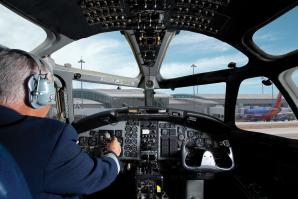Cindy Nichol became director of the Sacramento County Airport System in October 2018, bringing more than 30 years of experience in airport management to the position. Her career includes stints at San Francisco International Airport and the Port of Portland. Comstock’s recently spoke with Nichol about the four-airport system she oversees.
Tell me about the Sacramento County Airport System.
We have four airports, and each one is really different. Sacramento International Airport is 50 years old and is owned and operated by the county. Mather Airport came over to the county from the Air Force in the mid-’90s. Because it’s 100 years old, it has a lot of old infrastructure, but it’s a huge asset. We have a really long runway — 11,000 feet, which is about a third longer than most runways at commercial service airports. We have a lot of space here yet to be developed. The third airport is Sacramento Executive Airport, which is south of downtown, and it’s an interesting one because it’s actually owned by the City of Sacramento. … We have a long-term lease to operate the airport. The last one is Franklin Field, which is down in the south part of the county. It’s used mostly for flight training and crop dusters. The only airport where we have commercial services for passengers is the International Airport.
During your time as director, what have you identified so far as areas for improvement for the airport system?
We’ve had phenomenal success in air-service development. We have three new airlines coming in — Spirit, Sun Country and Contour, serving Santa Barbara. We also have airlines that have been serving the International Airport expanding to new routes. (That) better serves our community and our businesses, people who are here and want to go places, and people who want to come here either for business purposes or for tourism. We’re trying to emphasize to people we’re super close to Napa and Sonoma, and it’s actually easier to come into Sacramento and head over there than to fly into Oakland or San Francisco. We also don’t think people realize how close we are to Tahoe or to Yosemite, so those are things we’re trying to get out there. … The challenge in that is we’re growing so fast — we’re growing faster than most airports in the country — and we’re now outstripping the forecasts of where we would be, and we’re starting to outstrip our capacity of various facilities. It’s a good problem to have. But at International, we need more gates in the morning peak, which is 5 a.m. to 7 a.m. We need more aircraft parking. We need more auto parking. We need a new, more modern rental-car facility. We need to work on infrastructure, is the bottom line.
“So what do we think the future looks like, and, given how many passengers we’re going to have, what are their choices likely to be, and, therefore, how much of these different facilities are we going to need?” Cindy Nichol, Sacramento County Airport System Director
(In terms of) regular maintenance and making sure our airfields are the best they can be, we’re currently working on the runways at International. Last construction season, we worked on the east runway taxiway. This season we now have the west runway closed. We’re changing the runway over from asphalt to concrete. All our aircraft operations are taking place on our east runway right now; because our runways are widely spaced, we don’t have any capacity issues here, unlike San Francisco or other airports where I’ve worked. Here at Mather, we have two runways, including the 11,000-foot runway, and we have a shorter runway; we need to temporarily extend it in order for UPS to continue to operate. We’re doing that work this construction season. Next season, we’ll be working on the (longer) runway. The ends are concrete, which is more sturdy; the middle is asphalt. We’re also going to be putting in an instrument landing system, and once we’re done end of next year, aircraft will be able to operate in all weather conditions, pretty much, up to a visibility of 700 feet. (For cargo, that’s) huge — because they’re all about on-time delivery. … That dependability and not being concerned about the weather is a huge thing.
Why is it an asset to have an 11,000-foot runway?
When we have hot weather, in order to take off, aircraft need a longer runway or they need to take less cargo. So the advantage is they can be fully loaded and take off in the summer.
In terms of the facility needs at the International Airport, what are the next steps?
We are doing forecasts of passengers and aircraft operations. We’ll derive forecasts of how many gates we need to serve a five-year or a 10-year (period). We’ll also get forecasts of how much aircraft parking we need, how much automobile parking we need, what’s the demand for the rental cars. We get into interesting territory when we start thinking about ground transportation, which includes parking, rental cars, the transportation network companies. Uber and Lyft were not envisioned when the airport was built. Per day, we have about 500 (taxi and other forms of ground transportation) trips a day; Uber, Lyft and Wingz are more than 3,000. Another (mode) that’s harder to quantify is being picked up and dropped off by your friends and family. So what do we think the future looks like, and, given how many passengers we’re going to have, what are their choices likely to be, and, therefore, how much of these different facilities are we going to need? A wrench in the whole thing may be self-driving vehicles; we don’t know what that’s going to mean. Technology is continuing to change, and it’s going to influence what airports all look like in the future.
When can travelers expect to see some of these big changes?
In terms of some of the facilities at International, it’s probably a three-to-five-year timeframe. As you can imagine, once we know how many — let’s pick gates: gates we need, where do we put them? Once we have that decided, we have to design them. We have to figure out how to pay for them; we’re probably going to issue bonds. We have to get airline approval to do that — we have to tell the airlines about the project and they can vote it down. Then there’s the actual construction.
You said Sacramento International Airport is growing faster than most airports in the country. What do you attribute that to?
One is the overall strength of the economy here and the fact that we have a lower cost of living than the Bay Area, so we are seeing people move here, and our activity levels are driven by the economy as well as population. There are just more people here (who) want to fly. The other thing is all of our success in air service is helping. For example, people who want to go to Santa Barbara used to have to drive or go to San Francisco and fly from there. Now they can fly from here. Having better service means we’re able to serve our customers, both people who are starting their trips here and people who want to end up here, and they’re not going to other airports in the area. We’ve had more than six years now of growth. In the early years, it was about 4-7 percent per year. Last year was 10.4 percent. This year is going to be more than 9 percent. Because of all the air service we’re adding, it looks like that is going to be continuing for the next couple years, which is good but a little daunting. Not only are we putting these plans in place, but we’re also working to be very creative and really focusing on customer service and trying to manage this period while we’re in the planning process.
Here’s a great example (of addressing customer service). This increase in the transportation network companies; we had only four spaces for them to pick up people in Terminal B. We need more than 40. Traffic was getting backed up; that was causing everyone going to both terminals to be delayed, and that’s not good customer service. So we moved the pickup point … that means people have to walk for one minute and 15 seconds. I timed it with my own bag. It’s not ideal, but we had no idea this was going to happen, so there’s a lot of messaging to help people understand that we are trying to keep their service at a high level.
What’s the latest with plans to develop the 128 acres south of the airport?
Certainly, I expect it will be developed in the future. It’s just not something we have the resources to focus on right now. People ask me about hotels. … We haven’t done a hotel study in 10 years. I would want to do a hotel study, really understand who else is providing hotels in this area and do we need to do that.
What are the biggest challenges when it comes to the airport system?
The decision on how much capital to invest is not necessarily easy, because airports are very capital-intensive. If you think just about how much pavement we have at these airports, it’s a lot to maintain, plus investing in the other facilities. We need to be thinking about, longer term, what kind of economic cycles do we expect? When this airport opened Terminal B in 2011, there was a lot of hype about it being overbuilt. Well, here we are eight years later, and we’re out of gates in the morning peak. This is the challenge: You have to keep your eye on the long-term and build what you think you will need and do it judiciously.
Recommended For You

The Little Airport That Could
SMF navigates a nose dive
In September 2008, when Lehman Brothers collapsed and the municipal bond market froze, Sacramento International Airport had just begun constructing the biggest capital improvement project in the county’s history.




Comments
As a frequent airport user, as well as one who talks with a lot of people arriving here, I would say that more parking (in a structure) is very high priority as is a more user friendly car rental system. One you can walk to (perhaps in new parking structure) rather than being bussed which is definitely NOT user friendly. On site airport hotel would also be high priority
Rental car process is a mess. You have to add 30 minutes or more to any trip to be sure you'll catch your flight. I understand that capital expenditures take time to implement, but in the near-term, buy some more busses and staff-up to get people moving instead of standing in line for 20 or more minutes waiting for the forlorn little shuttle to finally pull-up to the curb. The rental car situation has been untenable for over a year. No more excuses. Get people moving. That's your job. Start doing it.
The ride share program is by far the most popular ground transportation, yet in Terminal B, you are subjected to a lengthy walk across the multiple lanes of traffic to reach a sidewalk which is uncovered to reach the Lyft and Uber pickup area. 3 times during the past several months, it has been raining, resulting being soaked by the time you get to the covered waiting booths.
There needs to be a more convenient and comfortable method to those using an incredibly rapidly growing segment of passengers using SMF.